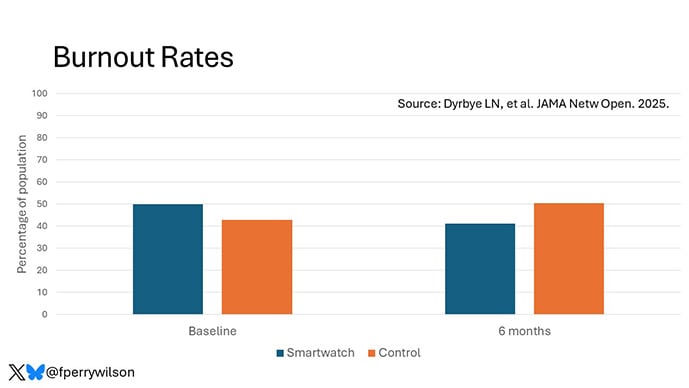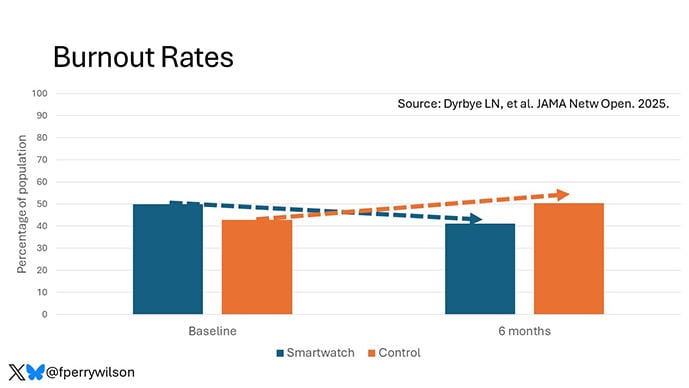This transcript has been edited for clarity.
Welcome to Impact Factor, your weekly dose of commentary on a new medical study. I’m Dr F. Perry Wilson from the Yale School of Medicine.
Burnout is a huge problem across multiple professions in the United States. Grades K-12 teachers have about a 50% burnout rate. So do people in quality assurance. But I was unable to find a profession with a higher rate of burnout, or a higher potential for harm from burnout, than — you guessed it — physicians.
A 2022 survey found that 63% of physicians had burnout, rates that have been among the highest of all US workers since 2011.
And this is a huge problem. When docs are burned out, they are more likely to commit medical errors, be named in malpractice suits, and even exhibit racial biases.
Administrators of health systems have taken notice. But their solutions have often been criticized as tone-deaf. “Mandatory burnout workshops” are not helping anyone’s burnout, I promise you. So I was a bit concerned by a study that came out this week that offered a relatively simple solution to what is a really complex problem. Can you actually cut burnout in half by giving physicians a smartwatch?
Before we dig into the study, let’s talk about burnout a little bit. I think there’s sort of a Potter Stewart definition of burnout: “I know it when I see it.” But the real description comes from Christina Maslach, who characterized it as a psychological syndrome brought about by chronic occupational stress characterized by emotional exhaustion, depersonalization or cynicism, and a reduced sense of personal accomplishment.
Sound familiar? I know. It’s not uncommon. And it goes without saying that depersonalization and cynicism are just terrible traits to have in a doctor.
It’s not just workload that leads to burnout, according to most psychologists; it’s this combination of workload and a feeling that you don’t have autonomy. That you are not the master of your fate or the captain of your soul.
Big issues. So how is a smartwatch supposed to help?
Well, the idea isn’t crazy. Smartwatches are miniature biofeedback devices. They tell you about your heart rate, your step count, how much you slept. Those little data points can lead to some real behavior change. This is anecdotal, but multiple people have told me they’ve cut back on drinking alcohol because they noticed that their smartwatch-reported sleep quality is worse on nights that they drink.
Researchers at the Mayo Clinic and University of Colorado thought that maybe giving smartwatches to physicians would lead them to make small lifestyle changes, like getting more sleep, that would reduce this problem of burnout. Here’s how the trial worked, as reported in JAMA Network Open.
One hundred and eighty-four physicians — about half attendings, half residents and fellows, and about 60% female — were randomized to two groups.
One group got a smartwatch, specifically the Venu 2 Plus from Garmin, to wear for 6 months. The other group got nothing. Well, to be fair, they got a smartwatch as well — just after a 6-month wait so the team would have 6 months of high-quality comparison data.
At the beginning of the study and several times over those 6 months, the participants took surveys about their mental health: a resilience survey, a quality-of-life survey, a depression survey, a stress survey, a sleep survey and, importantly, a burnout survey.
At baseline, 50% of people in the intervention arm were burned out and 43% were burned out in the control arm. After 6 months, burnout dropped to 41% in the intervention arm and rose to 51% in the control arm.


The difference here was not technically statistically significant, but after accounting for the fact that burnout was higher at baseline in the intervention group, the team concluded that the odds of burnout were about 50% lower after 6 months of the smartwatch intervention.
I know statistics can get confusing in situations like this. I think sometimes it helps just to look at the graph and make your own judgment: Burnout down a bit with a smartwatch, up a bit without a smartwatch. Fine.
There was also about a 20% improvement in resilience scores, while there were no differences in quality of life, depression, or stress scores.
So… is that it? Have we solved this problem plaguing all of healthcare and multiple other industries across the United States? Smartwatches?
My fear is that some C-suite execs will look at this study and think they can cut burnout rates in half by sending a bunch of smartwatches around. Maybe it seems obvious to you that it wouldn’t actually work, but let’s break down a bit how the results of this study may be somewhat skewed.
The most important thing to note is that this study was not blinded. The people in the smartwatch group knew they were in the smartwatch group because… they were wearing the smartwatch. It’s hard to imagine a way to blind this study, to be fair, although I suppose you could give everyone a smartwatch but half the people get fake data or something.
But once you know that you are in the intervention group, biases in your answers creep in. Just imagine you’re in the study. At baseline, you take these surveys, then they give you a smartwatch, and 6 months later you take a bunch of surveys again. Maybe you skew your answers a bit, even unconsciously, because you like the people running the study or science in general, or maybe even smartwatches.
The authors acknowledge this but minimize it, suggesting that if this “social desirability bias” was present, it should improve scores across all the surveys. I mean, okay, but to be honest, the score differences are pretty marginal across the board, so I don’t find that argument very compelling.
The real issue here is that this study puts the locus of control in the wrong place, as many burnout interventions do. It puts the responsibility for burnout on the shoulders of the burned-out physicians. It suggests we can tolerate our jobs better if we just change our outlook: Sleep more, meditate more, live in the moment, do tai chi, etc.
But I would argue that the problem with burnout is not in the mind of the physician; the problem is the system in which we work. More than 75% of physicians in the United States today are employed by hospitals, health systems, or other corporate entities. The private-practice model is rapidly dying and the physician workforce is learning what it means to be labor instead of management. They are feeling what it is like to be exploited, for lack of a better word — pushed to see more patients in less time, pushed to generate more RVUs, pushed to work weekends and nights to increase margins. It’s not what they signed up for.
The problem of burnout is from the system. If you want to cut rates in half, you don’t send docs a smartwatch. You give them more time to see fewer patients. You change the insurance system that leaves us on the phone arguing for prior authorization for hours at a time. And if that affects the bottom line of the health system, you look for cuts in the — and this is true — 10 administrators for each physician in the US.
Look, I love my smartwatch. It helps me delete emails while I’m waiting for the elevator. But the solution to physician burnout is not here. It’s out there.
F. Perry Wilson, MD, MSCE, is an associate professor of medicine and public health and director of Yale’s Clinical and Translational Research Accelerator. His science communication work can be found in the Huffington Post, on NPR, and here on Medscape. He posts at @fperrywilsonand his book, How Medicine Works and When It Doesn’t, is available now.
